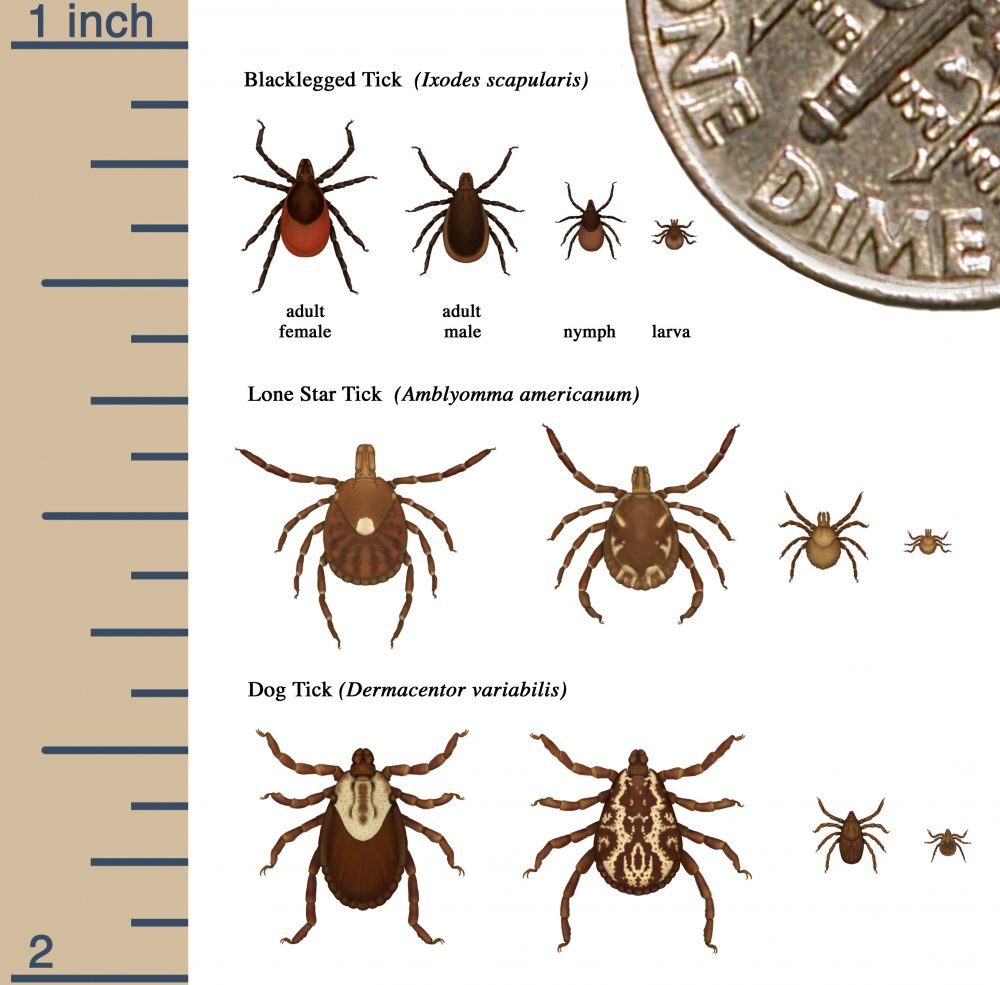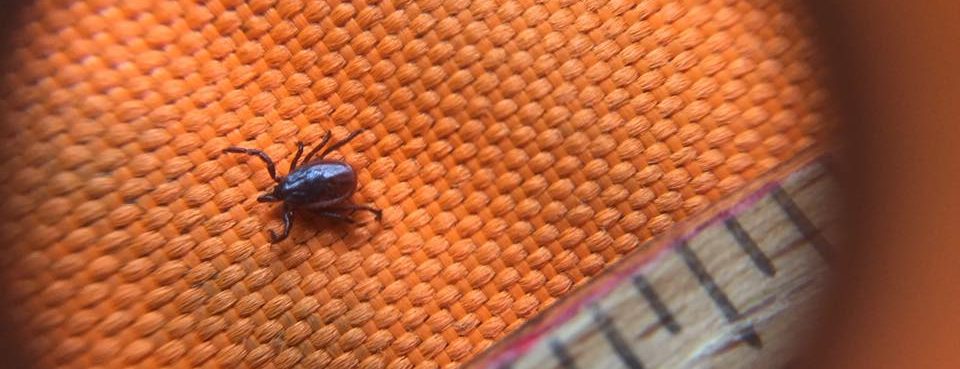Natural Insect and Tick Repellents
Spring tends to be the worst season for ticks in New Hampshire, and this year has been worse than ever. I’m pulling 10 to 30 ticks per day off myself and the dog every day, and that’s just walking in the yard! The life cycle of ticks makes spring prime time for bites (starting as soon as the snow melts), but any time of year is fair game for those nasty critters. I know folks who got bit in the depths of winter, bundled up in a snowsuit.
As if ticks weren’t creepy enough, they (as you well know) can carry Lyme disease and other serious, potentially debilitating co-infections including babesia, bartonella, anaplasma, ehrlichia, and mycoplasma, to name a few. Very rare but scary diseases like the Powassan virus and anaphylaxis to meat (most commonly associated with lone star ticks) have also entered the state. Here in New Hampshire, we have among the highest recorded rates of Lyme disease per capita in the whole country. (Also see CDC data here.)
So, what’s a lover of the outdoors to do?
Avoid Tick Bites
Employ a handful of tactics to limit your exposure to ticks and ability to remove them promptly before they can pass disease on to you or your pets. Nothing is a 100% guarantee, and doing more than one thing helps improve your odds of not getting bit. Some options include…
Dress the Part
- Long pants, tucked into your socks (super sexy)
- Light-colored clothing, to make it easier to see ticks
- Tall slippery-textured boots help cover your scent and make it harder for a tick to grab on. Bonus: they make the pants-in-socks look more fashionable by covering it up. 😉
- Clothing/boots treated with tick repellent such as pyrethrum (which is not without safety concerns), natural, or synthetic repellents — more on those in a bit.
Step Wisely & Choose Your Ecosystem
Ticks love grass (especially long grass) and shrubby areas, so keep lawn mowed relatively short and limit bush-whacking when hiking. If you do pass through a grassy meadow or decide to fly fish in the brush, make sure to check yourself regularly for ticks. Ticks also love mulch. I still use mulch in my garden because it’s so fantastic for my garden, suppressing weeds, and building the soil, but you’ll want to be extra vigilant when working with it. You may opt to employ these various tactics to make your yard less tick-friendly, work with a local pest control company to use natural sprays on your yard (double-check for human and pet safety), or give the DIY tick tubes a try.
Do Regular Tick Checks!
No matter what you do to help prevent tick exposure, you’ll still want to do thorough tick checks. Give yourself a good look-over while you’re outside and as soon as you come inside. Then, when possible, strip naked and do a thorough tick check of every nook and cranny — full-length or hand-held mirrors and good lighting are key. Ticks love warm, hidden spots like the groin, hairline/head, around the ears, back, inner thighs, under breasts, etc. Even in between your toes! Run your hands through your hair to feel around your scalp. They seem to know exactly which spots you can’t easily see. Taking a shower will not “drown” ticks (they’re quite hardy critters), but it might help you find them. Because ticks are so common in our household, we do a head-to-toe look over every night before going to bed.
Don’t forget to check your pets — they’re even more likely to pick up ticks than you are, and those ticks can also walk on over to you.
Some people like using the sticky tape lint roller to grab most ticks off their clothes. If you use it, fold it up after because ticks can crawl off the sticky surface unless they’re trapped on both sides.
Don’t forget that they could also be hanging out on your clothes, so look them over inside and out. According to this study, ticks might survive the washing machine (temps above 130°F might kill them; cold water will not), but tossing dry clothes directly in the dryer for six minutes should fry them.
Use a Tick Repellent
No tick repellent is 100% effective, but they can help reduce the risk of exposure. Our best natural options for tick repellents include lavender, rose geranium, citronella, lemon eucalyptus, and juniper essential oils as well as yarrow extract and pyrethrum-treated clothes. Learn more about these and other natural insect repellent tips in my blog post here. If I use them, I particularly focus on spraying them on my feet and legs.
Support Your Immune System
Some evidence suggests that a strong immune system can better fight tickborne infections so that they are less likely to occur or do so with less severity. Astragalus and/or medicinal mushrooms like reishi taken daily might be useful here, as might ashwagandha. (Note that some people with chronic Lyme do not tolerate astragalus.) Stephen Buhner’s books cover this topic in much greater detail, as do I in my other blog post on herbal care for Lyme and Co-infections. Your general wellbeing — eating a healthy, vital diet, getting enough sleep, moving regularly — may also impact your susceptibility to infection.
You Got Bit. Now What?
It helps to have a game plan in place so you don’t panic and can act promptly and systematically to reduce your risk and virulence of disease. Consider keeping tick-removal supplies in a few places — bathroom, first-aid kit, car, backpack.
Infection Likelihood & Potential Symptoms
This is a question hotly debated within the Lyme, medical, and holistic communities. (If you didn’t know, there is a Lyme War of opinions on this topic. Even the experts do not agree about how and when people are likely infected, how to diagnose disease, and how to treat disease.)
The more conservative and widely accepted in the medical community viewpoint is that only blacklegged “deer” ticks can pass on Lyme and the co-infections (with the exception of meat allergy via lone star ticks and Rocky Mountain spotted fever via dog ticks), and the tick needs to be attached for 36 to 48 hours to transmit the disease. That said, some evidence does suggest (but not conclusively prove) that other insects and ticks might transmit the disease, that disease might be sexually transmitted, that it might be transmitted from animal to person, and that disease may pass much faster than 36 hours, especially for younger ticks. The CDC and IDSA are more conservative groups whereas ILADS and the Lyme Disease Association are more proactive “Lyme-Literate” groups.
Potential symptoms of early onset Lyme or co-infections includes bulls-eye rash (which is definitive for infection and occurs in 70-80% of those affected, but many do not get or see the rash), other rashes, fever, joint pain/inflammation, headache, swollen lymph nodes (you feel like you have a really bad flu). These symptoms usually arise within the first 3 to 7 days after a bite but could emerge within a month. Untreated Lyme can develop additional symptoms including headaches, neck pain, more rashes, arthritis/joint/other pains, facial palsy, cardiac inflammation and issues, dizziness, nerve damage, cognitive issues, numbness, and more. Note that it’s common for a bite to get a small red bump; this does not necessarily indicate infection. For a longer list of potential symptoms from one of our more “Lyme literate” (less conservative) groups, see here.
Remove the Tick Safely
- Best: Use thin, pointy tweezers (my preference) or a tick spoon (might work better for squirmy kids or animals) to firmly grab the tick by the head as close to the skin as possible and pull out in a slow, steady movement. Don’t twist or jerk. Don’t squeeze the body of the tick.
- Do NOT: Use fire, Vaseline, or other method to try to back the tick out. Also do not squeeze the tick from back end. All these things might increase the amount of of disease-infected juices that get injected into you.

- Look at the Tick: Don’t just toss the tick right away. If it’s a blacklegged “deer” tick, the likelihood of infection is much greater. Here in New Hampshire, dog ticks and a few lone star ticks are also present and may bite humans. Use this site to identify your tick. Also examine the area — is it noticeably engorged? Does it appear that the tick was attached for a long period of time?
(Image source TickFreeNH.org/CDC) - Save the Tick for Testing? You can send your tick in for testing (at your expense) to see if it is carrying Lyme or other co-infections. It’s worth considering especially for blacklegged ticks that you suspect have been on attached for a longer period of time and could have transmitted disease (though more cautious folks may want to test every tick that bites them). Put the live tick in a Ziplock bag with a damp cotton ball. Various places will test ticks. I’m partial to the UMASS Laboratory of Medical Zoology’s Tick Report, which is a bit more detailed and affordable ($15-50+). The tests will identify diseases present in the tick and estimate how long it was attached, which can give you a good idea of what you could’ve been exposed to for a fraction of the cost and headache of human Lyme/co-infection testing (human tests are also hotly debated, have a high degree of false negative results, and the better tests may not be covered by insurance). For additional labs, see here.
- Partake in Some Citizen Science? If you want to send ticks in for testing but aren’t necessarily concerned about getting the results back , BeBop Labs is a nonprofit lab dedicated to gathering and sharing data on ticks and tick-borne diseases in northern New Hampshire. (They will only notify you of results if you give your email address, the tick was biting a human, and disease was detected; response time can be very slow – see more FAQ here). They will test ticks for free; however, this is more to gather broad data to inform the community at large about ticks and disease. Learn how to send ticks to BeBop Labs, and check out their site for fascinating tick data results.
- Or Dispose of It Properly: Do not squish it between your fingers. Not only are ticks notoriously difficult to kill (ticks are comic book Super Villains! they act dead for a bit, then walk away as soon as you forget about them), but you risk exposing yourself to the germs inside of it. Instead, try one of these methods: Tape it up (on both sides) to quickly immobilize it. Set it on fire (some find this very rewarding). Flush it down the toilet (wasteful of water but easy to do in a jiffy, especially if you’re already in the bathroom). Or put it in a jar, even better if it’s a jar of high-proof/rubbing alcohol to instantly kill the tick because they will survive for days to weeks in an enclosed jar and might crawl out as you put a new one tick in.
- Also check out my friend and colleague Dr. Cora Rivard, ND’s stellar blog posts on ticks in New England.
Prophylactic Remedy Options
If there is a strong likelihood that you have been exposed to Lyme and other co-infections (you were bit by a deer-tick, it’s been attached for a long time and is engorged, you have a bulls-eye rash, you have other suspicious symptoms), immediately see your doctor.
Antibiotics like doxycycline are, hands down, the best method to treat early or acute Lyme and to nip it in the bud. (Doxy can cause a lot of nausea, should not be taken alongside dairy or minerals because they can decrease its efficacy, and may make you more sensitive to the sun. So, obey doctor/pharmacist instructions, be extra careful with sunscreen and sun exposure, and take a good-potency probiotic alongside.) The length of course of antibiotics is hotly debated; most doctors will only prescribe a 1-2 day course while other more cautious/Lyme-literate doctors will go for 10-30 days. Antibiotics efficacy in late-stage or chronic Lyme is also debated.
Herbal Options include supporting your immune system (echinacea, astragalus, reishi) and those that may directly fend off infection including Japanese knotweed, cat’s claw, and low-dose teasel root.
Maria’s Tick Blend Tincture
I can’t prove that this works, but this is the formula that I take when I’ve been bit by a tick. I will still go for antibiotics (via my doctor) if the bite seems to be of high-risk for infections.
- 19% Echinacea Root (fresh 1:2)*
- 15% Cat’s Claw (dry 1:5)
- 15% Red Root (dry 1:5)
- 15% Japanese Knotweed Root (fresh 1:2, 10% glycerine)
- 15% Astragalus Root (dry 1:5 decoction tincture)*
- 10% Usnea Lichen (dry 1:5)*
- 10% Bee Balm (fistulosa) Aerial (fresh 1:2 or dry 1:5) (strong oregano is similar)
- 1% Teasel Root (fresh 1:2)
- 5 drops per bottle Garlic Chive Flower Essence
My dose for this is 1 to 5 ml, 1 to 3 times per day for a few weeks to one month, depending on how suspicious the bite is. Dry herbs are from Mountain Rose Herbs. Fresh herbs from my garden or a colleague’s organically maintained property. Make special care not to propagate/spread Japanese knotweed as it’s highly invasive and technically illegal to harvest or transport. (* People who already have chronic Lyme may experience a flare-up with echinacea and astragalus. If this is a concern, skip these herbs and consider bumping up the Japanese knotweed, cat’s claw, and red root. Also, according to Debbie Mercier, some people with sulfur allergies get hive-y with usnea.) I do not sell this formula or herbs in general but am sharing the blend in case you’d like inspiration for making your own.
Misty Meadows in Lee, NH makes and sells a lovely Lyme Protocol
Greenwood Herbals offers various Lyme support blends
Sacred Tree Herbs in Meredith, NH is also worth visiting
Practitioner Support
It’s always a good idea to check with your pharmacist on herb-drug interactions and keep your doctor in the loop. These herbs are unlikely to interact negatively with antibiotics and can likely be taken alongside; however, they may interact with other pharmaceuticals. Do not hesitate to visit your doctor and/or hire a Lyme-literate doctor, naturopath, or herbalist to support you. I do work with clients who have Lyme, but it’s not the prime focus of my practice, and I generally schedule several weeks out on new appointments. One of my favorite herbalists for Lyme care is Debbie Mercier at Greenwood Herbals, she sees clients in her Limerick, Maine office and distance and collaborates with some of the world’s most famous Lyme doctors.
Clinical herbalist Maria Noël Groves sees clients and teaches classes at Wintergreen Botanicals Herbal Clinic & Education Center in Allenstown, New Hampshire.
The statements made on this blog have not been evaluated by the FDA and are not intended to diagnose, prescribe, recommend, or offer medical advice. Please see your health care practitioner for help regarding choices and to avoid herb-drug interactions.








